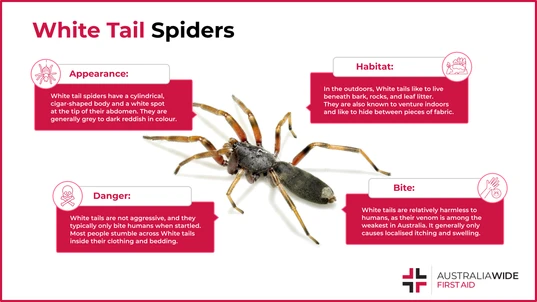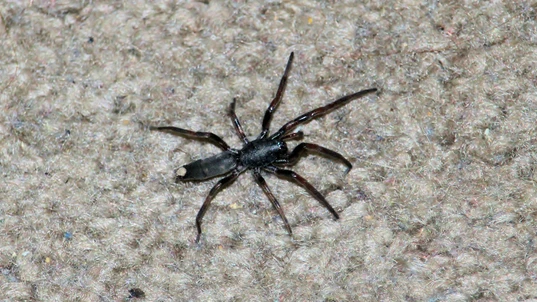Everything You Need to Know About the White Tail Spider

Bites and Stings

The White tail spider is native to Australia and New Guinea. They are vagrant hunters that prefer to prey at night in and around the family home. Its bite has long been associated with ulcerating lesions, but whether this is true continues to be debated.
The White-tailed spider, which is more commonly known as the White tail spider, is native to Australia and New Guinea. It is commonly found in bush and urban environments across the country, and its bite has been sensationally associated with a phenomenon called necrotic arachnidism. The question is, is the White tail spider really the flesh-eating monster that the media has made it out to be? Let’s take a closer look… We also cover spider bites in our general and childcare first aid courses. We have training locations in every state, capital city, and major town throughout Australia. To find and enrol in a first aid course near you, head to our website.Introduction
There are two common species of White tail spider, Lampona cylindrata and Lampona murina, both of which form part of the Lampona genus that is native to Australia. The White tail spider is a vagrant hunter. Rather than spinning webs to catch and eat insects, it prefers to stalk and feast on other spiders in the dead of night, including Curtain-web spiders, Daddy-long-legs spiders, Redback spiders, and Black house spiders.Appearance
The White tail spider has a cylindrical, cigar-shaped body that is grey to dark reddish in colour. Their most distinctive feature is a white spot on the tip of their abdomen. White tails that are grey in colour also sometimes have two pairs of faint white spots on the top of their dorsal abdomen, though these tend to be less distinct in adults. They are also known to have dark orange-brown bands on their legs, which can span up to 5 cm in length.Looking to get you First Aid knowledge up to date?
We run certified First Aid courses throughout all major Acustralian citys. Find a location near you.
Distribution and habitat
Lampona murina is found in eastern Australia, including northeast Queensland, New South Wales, and Victoria. Lampona cylindrata, meanwhile, prefers the cold, and can be found across southern Australia, including southeast Queensland, New South Wales, Victoria, South Australia, Tasmania, and southern Western Australia. In the outdoors, the White tail spider likes to live beneath bark, rocks, and leaf litter. However, when the weather gets warm, they tend to roam into houses and hide in sheltered nooks, crannies, and between pieces of fabric. Females also build temporary silk retreats to house their disc-shaped egg sacs.Behaviour
The White tail spider is not aggressive, and they typically only bite humans when they are startled. In fact, most victims sustain a bite on the arms or legs when they brush against a White tail spider in their clothes, towels, or bedding.Symptoms
The White tail spider is relatively harmless to humans, as their venom is among the weakest of Australian household spiders. Most bites only result in mild symptoms similar to those of a bee sting - specifically, an immediate burning sensation in the affected area followed by mild swelling and an itchy red mark that tends to resolve within 24 hours. In rarer cases, a White tail spider bite can cause:- Severe pain or discomfort at the bite site
- Nausea, vomiting, headache, or a general feeling of unwellness

The White tail spider is known to wander around houses. However, they are not actively aggressive towards humans and prefer to prey on the Black house spider, among others.
Necrotic arachnidism
Since the 1980s, there have been numerous media reports associating the White tail spider bite with severe ulcerative skin lesions. However, in most of these cases, there was no direct evidence of a White tail spider bite. Likewise, a 2003 study conducted by envenomation expert Dr Geoff Isbister produced no cases of ulceration, despite testing over 100 verified cases of White tail spider bites. As such, the available evidence suggests that White tails are very unlikely to cause severe ulcerations.First aid
- Reassure the casualty and keep them under constant observation
- Apply a cold compress to the bite site for periods of up to 20 minutes to lessen the pain
- If the casualty is a young child (under 8 years), a pregnant woman, or if they exhibit any signs of deterioration, follow the basic life support guidelines per DRSABCD and call Triple Zero (000) for an ambulance
- DO NOT use the Pressure Immobilisation Technique, as the venom moves slowly and this will just worsen the pain
- If you are worried about your symptoms, or if they get worse instead of better, seek medical attention
Anaphylaxis
Some people can have a severe allergic reaction to a White tail spider bite. This is called anaphylaxis, a condition that can be fatal in as little as 15 minutes. Symptoms include:- Tightness of the throat from swelling
- Difficulty breathing
- Tongue and facial swelling
- Hoarse voice or difficulty speaking
- A wheeze or persistent cough
- Collapse or falling unconscious
- Becoming pale or floppy (young children)
- Abdominal pain and vomiting
- Hives, welts, and body redness
Final thoughts
Native to Australia and New Guinea, the White tail spider is common to tight spaces in and around the home. They are not aggressive towards humans - in fact, they are largely considered a useful house guest, as they are known to kill more dangerous spiders like Redback spiders and Funnel-web spiders. If you sustain a White tail spider bite, do not panic – despite what the media says, you are likely to only develop localised pain and swelling rather than necrotic ulcers. Seek medical attention if your symptoms persist or cause you concern.Recommended resources
For more details on how to identify and treat bites from some of Australia's deadliest spiders, head to our Resource Library. We also have articles on what to do if you get stung or bitten by a snake, fire ant, and different types of marine life. We cover all these topics and more in our general and childcare first aid courses - head to our website to find and enrol at a training location near you. Disclaimer: This article is for informational purposes only. It does not constitute, replace, or qualify as any form of first aid training.
Originally published at
https://www.australiawidefirstaid.com.au/resources/white-tail-spider
as part of the Australia Wide First Aid Articles Library









